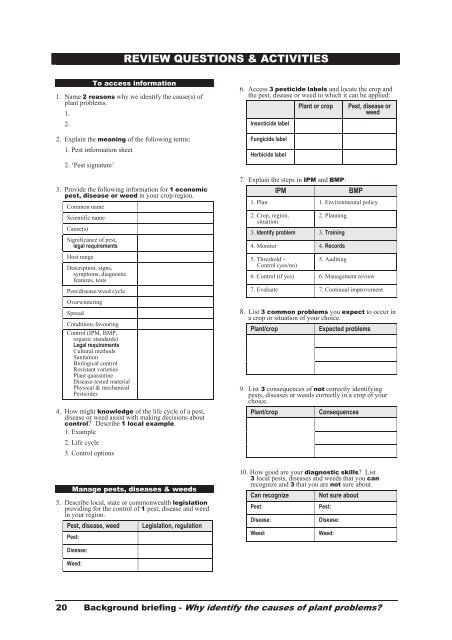PLANT PROTECTION 4
PLANT PROTECTION 4
PLANT PROTECTION 4
You also want an ePaper? Increase the reach of your titles
YUMPU automatically turns print PDFs into web optimized ePapers that Google loves.
REVIEW QUESTIONS & ACTIVITIES<br />
To access information<br />
1. Name 2 reasons why we identify the cause(s) of<br />
plant problems.<br />
1.<br />
2.<br />
2. Explain the meaning of the following terms:<br />
1. Pest information sheet<br />
2. ‘Pest signature’<br />
3. Provide the following information for 1 economic<br />
pest, disease or weed in your crop/region.<br />
Common name<br />
Scientific name<br />
Cause(s)<br />
Significance of pest,<br />
legal requirements<br />
Host range<br />
Description, signs,<br />
symptoms, diagnostic<br />
features, tests<br />
Pest/disease/weed cycle<br />
Overwintering<br />
Spread<br />
Conditions favouring<br />
Control (IPM, BMP,<br />
organic standards)<br />
Legal requirements<br />
Cultural methods<br />
Sanitation<br />
Biological control<br />
Resistant varieties<br />
Plant quarantine<br />
Disease-tested material<br />
Physical & mechanical<br />
Pesticides<br />
4. How might knowledge of the life cycle of a pest,<br />
disease or weed assist with making decisions about<br />
control? Describe 1 local example.<br />
1. Example<br />
2. Life cycle<br />
3. Control options<br />
Manage pests, diseases & weeds<br />
5. Describe local, state or commonwealth legislation<br />
providing for the control of 1 pest, disease and weed<br />
in your region.<br />
Pest, disease, weed Legislation, regulation<br />
Pest:<br />
Disease:<br />
Weed:<br />
6. Access 3 pesticide labels and locate the crop and<br />
the pest, disease or weed to which it can be applied:<br />
Insecticide label<br />
Fungicide label<br />
Herbicide label<br />
Plant or crop Pest, disease or<br />
weed<br />
7. Explain the steps in IPM and BMP:<br />
IPM BMP<br />
1. Plan 1. Environmental policy<br />
2. Crop, region,<br />
situation<br />
2. Planning<br />
3. Identify problem 3. Training<br />
4. Monitor 4. Records<br />
5. Threshold -<br />
Control (yes/no)<br />
5. Auditing<br />
6. Control (if yes) 6. Management review<br />
7. Evaluate 7. Continual improvement<br />
8. List 3 common problems you expect to occur in<br />
a crop or situation of your choice.<br />
Plant/crop Expected problems<br />
9. List 3 consequences of not correctly identifying<br />
pests, diseases or weeds correctly in a crop of your<br />
choice.<br />
Plant/crop Consequences<br />
10. How good are your diagnostic skills? List<br />
3 local pests, diseases and weeds that you can<br />
recognize and 3 that you are not sure about.<br />
Can recognize Not sure about<br />
Pest: Pest:<br />
Disease: Disease:<br />
Weed: Weed:<br />
20 Background briefing - Why identify the causes of plant problems?







![[Compatibility Mode].pdf](https://img.yumpu.com/27318716/1/190x135/compatibility-modepdf.jpg?quality=85)









